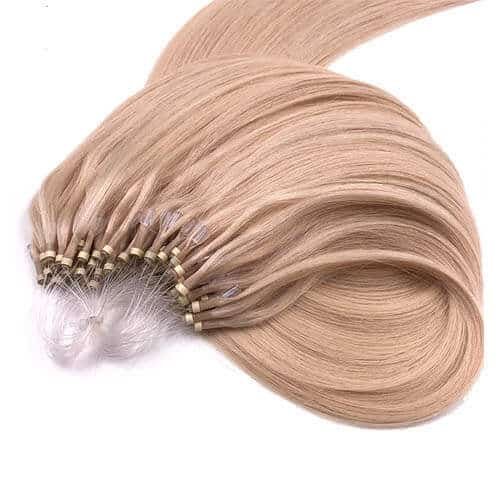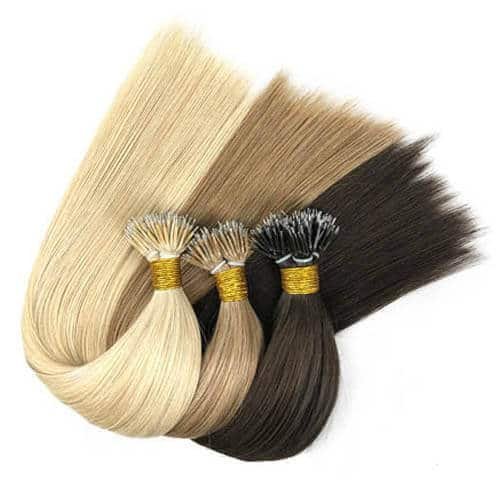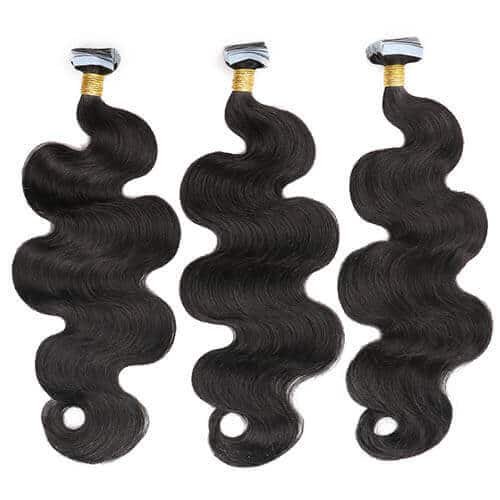Last Updated on 09/15/2025 by Eva Liu
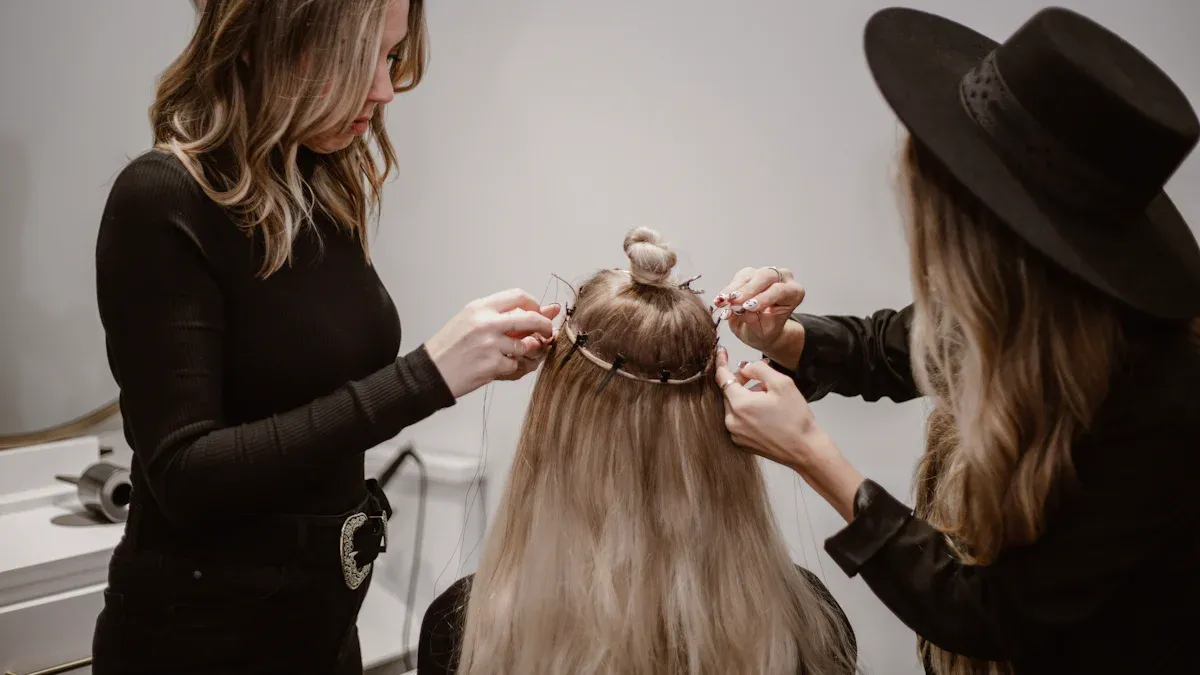
Are you thinking about using weft hair extensions this year? You are not the only one! Many people like quick changes and trying new colors. They also want to feel more confident. Some people want to protect their real hair. Others want to avoid the weird stage when hair grows out.
The world market for hair extensions weft is growing fast. It will be worth $2,760.9 million in 2025. It is expected to grow by 7%.
Shopping online and new invisible wefts make it easier to find what you want.
You can feel happy and sure about trying new looks!
What Are Weft Hair Extensions?
Definition and Benefits
You might wonder what weft hair extensions are and why so many people choose them. Weft hair extensions use real human hair sewn onto a long, horizontal strip called a weft. A stylist attaches small segments of these hair extension wefts to your natural hair, securing them with beads at the roots. This method uses professional sewing threads and beads, which helps boost your hair’s volume, thickness, and length. You usually need a professional to install them, so your hair stays healthy and safe.
Why do beginners love weft hair extensions? Here are some reasons:
You get instant length and volume. You can see a big change overnight.
You can style your hair in many ways. Curl it, straighten it, or try highlights and lowlights.
Your hair looks natural. A good stylist matches the color and texture to your own hair.
The results last for months if you take care of them.
You don’t need to style your hair every day. Just wash it once or twice a week.
When installed correctly, they don’t damage your natural hair.
Weft hair extensions give you a quick way to change your look. You can enjoy fuller, longer hair with very little effort.
Main Types: Hand-Tied, Machine, Hybrid
You will find several types of weft extensions on the market. Each type has its own pros and cons. Let’s break down the main types of hair wefts:
Type | Pros | Cons |
|---|---|---|
Natural seamless look | Long installation process | |
Hybrid Wefts | Blend of comfort and style | Fewer installation options |
Machine-Bonded Wefts | Affordable | Heavy and bulky |
Hand-tied wefts are a popular type of extension because they look and feel natural. Hybrid wefts mix the best features of hand-tied and machine wefts. Machine-bonded wefts are great if you want something sturdy and beginner-friendly.
You can also choose between human hair extensions and synthetic hair extensions. Human hair feels and looks real, while synthetic hair extensions cost less but may not blend as well. When you shop for hair extensions weft, think about your needs and which types of weft extensions fit your style.
Choose the Right Weft for Your Hair
Assessing Hair Type and Lifestyle
You want your new look to feel natural and easy. Before you pick hair extensions weft, take a close look at your own hair and your daily habits. Your hair’s texture, thickness, and how you live each day all play a big part in finding the best match.
If you have fine or thin hair, lightweight options like hand-tied wefts or tape-in extensions work well. These add volume without making your hair feel heavy.
For thick or dense hair, machine wefts or sew-in wefts give you the support and durability you need.
Curly or wavy hair? Pre-textured human hair wefts or hand-tied extensions blend in smoothly.
Your lifestyle matters, too. Do you play sports, swim, or move around a lot? Sew-in wefts stay secure and hold up well for active people. If you want something quick and easy, clip-in hair extensions weft or wire extensions let you change your style in minutes. Ponytail extensions add instant glamour for special occasions. Tape-ins offer a semi-permanent solution if you want a look that lasts but still feels light.
Here are some things to think about when you choose the right weft:
How much time do you spend styling your hair each day?
Do you want a style that lasts for weeks or something you can remove at night?
Will you need to match extensions to your hair type, color, and texture for a seamless blend?
Are you ready for the upkeep that comes with certain types of weft hair extensions?
A professional stylist can provide expert advice on the best extensions for your hair type, assist with color matching, and ensure proper installation for comfort and longevity.
Consultation and Personal Preferences
Getting advice from a stylist makes a big difference. You might feel unsure about which weft hair extensions to pick, but a professional can help you avoid mistakes. They look at your hair’s thickness, texture, and color. They also listen to what you want—maybe you dream of longer hair, more volume, or a new shade.
Here’s how a consultation usually goes:
The stylist checks your hair’s health and density.
You talk about your daily routine and style goals.
They show you different types of hair extensions weft and explain how each one works.
You get recommendations for matching extensions to your hair type and lifestyle.
The stylist helps you choose the right weft, so you feel confident and happy with your new look.
You can ask questions and share your preferences. Do you want something low-maintenance? Are you looking for a bold change or just a little boost? Your stylist will guide you through the options and help you make the best choice for your hair and your life.
Tip: Always ask your stylist about aftercare and maintenance. This helps your extensions last longer and keeps your natural hair healthy.
Matching Hair Extensions Weft to Your Look
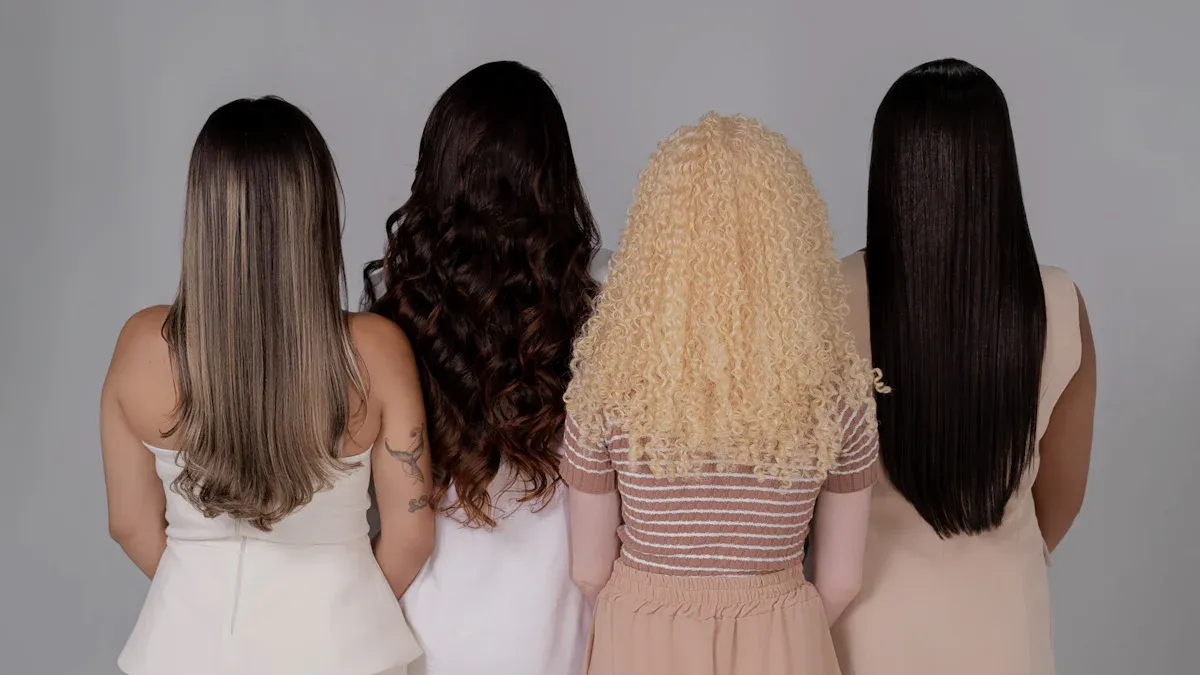
Texture, Density, and Color Match
You want your hair extensions weft to look just like your own hair. The secret is matching texture, density, and color. If you get this right, nobody will know you are wearing extensions. You will feel confident every day.
Here are some ways to make sure your weft hair extensions blend perfectly:
Try using more than one shade of hair extension wefts. Mixing highlights and lowlights gives your hair movement and a natural flow.
Ask your stylist to use a color ring. This tool lets you compare weft strands with your real hair in different lighting. You get a better match.
Pick extensions that have the same texture as your own hair. If your hair is curly, choose curly wefts. If it is straight, go for straight ones. This helps you avoid awkward lines or bumps.
Make sure the fiber patterns line up. When the patterns match, your hair looks smooth and feels comfortable.
Use low-heat styling tools and curl-defining products. These help your extensions and natural hair blend together.
Tip: Always check your hair in natural light before you decide on a color. Indoor lights can make colors look different.
If you want the perfect hair weft, talk to your stylist about your hair type and style goals. They can give you recommendations that fit your look and lifestyle.
Length Selection Tips
Choosing the right length for your weft hair extensions is just as important as matching color and texture. You want your new hair to fit your face shape and style.
Here are some tips to help you pick the best length:
Think about your natural hair length and the style you want. Extensions should add instant length and volume, but not look fake.
For layered styles, ask your stylist to customize the length of your perfect hair weft. Layers create volume and texture, making your hair look fuller.
If you want versatility, choose extensions that are 2-4 inches shorter than your dream length. You can style them in many ways—ponytails, braids, or waves.
Look at your face shape. Longer extensions can make your face look slimmer. Shorter ones can highlight your cheekbones or jawline.
Face Shape | Recommended Extension Length | Style Tip |
|---|---|---|
Round | Longer (16-22 inches) | Adds length, slims the face |
Oval | Any length | Most styles work well |
Square | Medium to long (14-20 in) | Soft waves add movement |
Heart | Medium (12-18 inches) | Layers balance the chin |
Note: If you are not sure, start with a medium length. You can always go longer next time!
The perfect hair weft should match your style and make you feel great. Human hair extensions give you the most natural look and let you style your hair any way you want. Ask your stylist for recommendations based on your face shape and daily routine.
Weft Hair Extensions Application Methods
Choosing the right installation methods for weft hair extensions can change your look and fit your lifestyle. Let’s break down the most popular ways you can get that dream hair.
Sew-In
Sew in weft hair extensions give you a long-lasting style. Your stylist braids your natural hair, then sews the weft onto the braids. This method works best if you have thick or coarse hair. You get a seamless blend and lots of volume. Sew in weft hair extensions can last up to three months with good care. You might spend a few hours at the salon, but the results look natural and stay secure.
Clip-In
Clip-in extensions offer a quick fix for instant volume and length. You simply clip the wefts into your hair at home. This method suits busy people or anyone who wants to switch up their style for a night out. Clip-ins work well for fine or thin hair because they are lightweight. You can remove them easily and try different looks without a salon visit. If you want low-maintenance human hair extensions, clip-ins are a great choice.
Micro Link-In
Micro link-in extensions use tiny beads to attach the weft to your natural hair. You don’t need heat or glue for this method. Micro link-in weft hair extension installation feels comfortable and lasts up to four months with regular tightening. This method fits active lifestyles and lets you style your hair in many ways. If you have fine hair, the beads might show, so ask your stylist for advice.
Glue-In
Glue-in extensions use a special adhesive to attach the weft to your hair. You get a fast transformation, and this method costs less than others. Glue-in weft hair extension installation works best for short-term use. If you want a new look for a weekend or event, glue-ins are easy. Be careful, though—improper application can damage your hair. Always ask your stylist about how to remove weft hair extensions safely.
Pros and Cons of Each Method
Here’s a quick table to help you compare the main methods:
Method | Pros | Cons |
|---|---|---|
Sew-In | Long-lasting, natural blend, great for thick hair | Time-consuming, may cause stress on hair |
Clip-In | Easy to apply, low-maintenance, versatile application | Not permanent, may slip in very fine hair |
Micro Link-In | No heat or glue, durable, fits active lifestyles | Beads can show in fine hair, needs tightening |
Glue-In | Fast, affordable, good for short-term use | Can damage hair, limited styling options |
When you pick a method, think about your hair type, how much time you have, and your style goals. Sew in weft hair extensions suit thick hair and give you a lasting look. Clip-ins and micro link-in extensions work for busy schedules and active lives. Glue-ins offer a quick change but need careful handling. Every method has its own benefits, so talk to your stylist about which weft hair extension installation fits you best.
How to Take Care of Weft Hair Extensions
Taking care of your weft hair extensions is the secret to long-lasting results and a flawless look. If you want your new hair to stay soft, shiny, and tangle-free, you need regular maintenance and the right habits. Let’s break down how to take care of weft hair extensions step by step.
Washing and Conditioning
You don’t need to wash your extensions every day. Try washing them two or three times a week. On days you skip washing, dry shampoo keeps your hair fresh. Before you wash, gently brush your extensions to remove tangles. Use sulfate-free and paraben-free shampoo to protect the hair. Massage the shampoo into the weft line with your fingertips, then rinse with lukewarm water. Apply conditioner from the middle to the ends, but avoid the roots and bonds. Deep condition every other wash for extra moisture. Pat your hair dry with a soft towel and let it air dry or use low heat. Never sleep with wet hair!
Tip: Wash row by row if you have multiple rows of extensions. Rinse well to prevent product build-up.
Styling and Heat Protection
You can style your extensions just like your own hair, but you need to protect them from heat. Always use a heat protectant spray before using hot tools. Try to keep the temperature between 250°F and 350°F. Start with the lowest setting and test a small section first. Give your extensions breaks from heat styling to keep them healthy.
Heat Setting Range | Recommendation |
|---|---|
250°F to 350°F | Safe for styling without damage |
Test small section | Always test before applying heat everywhere |
Note: Ask your stylist for tips on caring for your weft extensions. Many salons offer workshops to help you learn new techniques.
Preventing Shedding and Tangling
Caring for your weft extensions means keeping them smooth and strong. Choose high-quality extensions with intact cuticles. Brush gently every day with a wide-tooth comb or loop brush, starting at the tips. Wash with care and avoid rough motions. At night, braid or loosely tie your hair and sleep on a silk or satin pillowcase. Limit heat styling and always air dry when possible.
Remember: Regular maintenance helps prevent shedding and tangling, so your extensions look beautiful for months.
Do Weft Extensions Damage Your Hair?
Worried about the health of your hair when you try weft hair extensions? You’re not alone. Many people ask, “do weft extensions damage your hair?” The truth is, extensions can be safe if you follow the right steps, but there are risks you should know about.
Minimizing Risk
You can keep your hair healthy and avoid problems by following some simple tips. Most damage comes from mistakes during installation, too much weight, or skipping maintenance. Here’s what you can do to protect your hair:
Gentle Brushing: Use a wide-tooth comb or a special extension brush. Start at the ends and work your way up.
Avoid Oily Products: Pick lightweight serums so beads don’t slip out.
Wash with Care: Wash your hair only two or three times a week. Use sulfate-free shampoo.
Heat Styling: Always use heat protectant spray. Keep the temperature low.
Proper Installation: Go to a certified stylist for your extensions.
Regular Aftercare: Visit your stylist every 6-8 weeks for checkups.
Loose Hairstyles: Don’t pull your hair too tight. Loose styles help prevent strain.
Tip: If you notice any discomfort or tightness, talk to your stylist right away.
Clinical studies and expert reports show that improper installation or removal can cause traction alopecia, thinning, or bald patches. Here’s a quick look at what the experts say:
Source | Evidence |
|---|---|
Consumer Reports | Extensions can cause traction alopecia due to pulling and excess weight. |
Treatment Rooms London | Improper application leads to stress on hair follicles. |
Crown Clinic | Incorrect removal may cause bald patches, especially in Afro-Caribbean hair. |
Wimpole Clinic | Studies show extensions can lead to thinning and traction alopecia. |
Signs of Damage and What to Do
You should watch for early signs of damage. Catching problems early helps you fix them before they get worse. Here’s what to look for and what you can do:
Signs of Damage | What You Should Do |
|---|---|
Frayed Strands and Split Ends | Check spots where extensions attach. Trim split ends regularly. |
Dry or Brittle Texture | Use sulfate-free products to add moisture. |
Shedding or Breaking Strands | Too much shedding means poor quality or bad installation. |
Tangled or Matted Extensions | Brush gently. Severe matting needs a professional’s help. |
If you see tangles or knots, brush gently and avoid pulling.
For dry or brittle hair, switch to moisturizing products.
If shedding gets worse, visit your stylist for advice.
Severe matting or bald patches mean you should get help from a professional right away.
Note: Prevention is easier than repair. Take care of your extensions and your natural hair will stay strong and healthy.
Common Mistakes with Weft Hair Extensions
Trying weft hair extensions for the first time feels exciting, but you might run into some common mistakes. Don’t worry! You can avoid these errors and get the look you want.
Wrong Type or Method
You might pick the wrong type or method if you skip a consultation or rush your decision. Some beginners try to install complex extensions like sew-ins or MicroLinks at home. This can damage your natural hair. You should always talk to a stylist about your lifestyle and hair care routine. Ask questions about how you style your hair and how much time you spend on it. Your stylist will help you choose the best method for your needs.
Here are some mistakes to watch out for:
Not backcombing your roots before clipping in extensions. This can make them slip out.
Applying extensions too tightly or too loosely. Tight extensions hurt your scalp, while loose ones fall out.
Placing extensions too close to your hairline. You want them about half an inch away for a natural look.
Tip: Avoid self-installing tape-ins, sew-ins, or fusion extensions. Let a professional handle these for you.
Poor Color or Texture Match
Choosing the wrong color or texture makes your extensions stand out in a bad way. If the shade does not match your ends, you get a visible line. Mismatched textures feel uncomfortable and tangle easily. You want your extensions to blend in, not stick out.
Different fiber patterns cause tangling and breakage.
Unmatched textures may feel itchy or heavy.
Ask your stylist to use a color ring and compare strands in natural light. Try mixing highlights and lowlights for a softer look.
Skipping Aftercare
Aftercare keeps your extensions looking fresh. Many beginners forget to brush gently or use the right products. You might scrub too hard when washing or use too much heat when drying. Some people tie up wet hair, which leads to damage. Regular maintenance appointments help your extensions last longer.
Don’t forget these steps:
Brush with a wide-tooth comb every day.
Wash with sulfate-free shampoo.
Dry your hair gently and avoid tying it up when wet.
Visit your stylist for checkups.
Note: Good aftercare means fewer tangles, less shedding, and a style that lasts.
Weft Hair Extensions Cost and Value
Price Range and Factors
You probably want to know how much you’ll spend on weft hair extensions. Prices can vary, but most people pay between $200 and $600 for a full set in 2025. The cost depends on several things. You need to think about the type of hair, the length you want, and how many packs you need for your style. High-quality hair, like Remy, costs more because it looks natural and lasts longer. The stylist’s experience also matters. Skilled professionals may charge more, but they give you better results. Where you live can change the price, too. Salons in big cities often cost more than those in smaller towns.
Here are the main factors that affect the price:
Quality and type of hair used
Desired length and volume
Expertise and experience of the stylist
Geographical location and salon pricing
Additional services and aftercare products
You can’t install weft hair extensions by yourself. You need a professional to weave or braid them into your hair. Custom color matching and extra treatments can add to the total cost.
Getting the Most for Your Money
You want your investment to last and look great. Here are some tips to help you get the best value:
Research and compare prices from different suppliers.
Set a budget that fits your needs and goals.
Meet with stylists for quotes and advice.
Think about long-term costs, like maintenance and replacement.
Save up and plan ahead for your purchase.
Ask about payment plans if you need help managing costs.
Take care of your extensions to make them last longer.
Tip: Choose a qualified stylist and ask about warranties or guarantees. Good maintenance keeps your extensions looking fresh and saves you money over time.
Proper care and regular checkups help you avoid extra expenses. Some salons offer warranties, so you can protect your investment. If you want to save, try partial enhancements instead of a full set. Scheduling regular maintenance also helps you avoid surprise costs.
You’ve learned the basics of picking weft hair extensions in 2025. Here’s what you need to remember:
Know the types—clip-in, tape-in, and beaded wefts all offer different benefits.
Check prices before you buy. Some extensions cost $10, while others go up to $200.
Take care of your new hair. Wash gently, use the right comb, and protect from heat.
Take your time, ask questions, and trust your stylist. You can rock a fresh look with confidence! ✨



